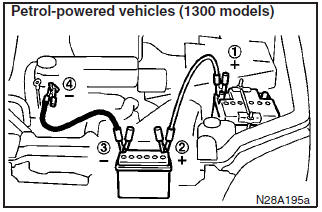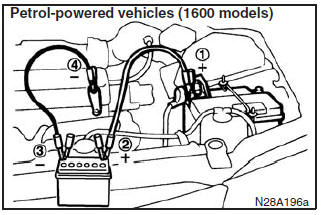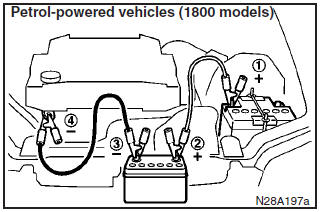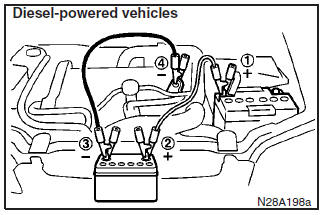Emergency starting
If the engine cannot be started because the battery is weak or dead, the battery from another vehicle can be used with jumper cables to start the engine.
WARNING
To start the engine by use of jumper cables from another vehicle, perform the correct procedures according to the instruction manual. Incorrect procedures could result in a fire or explosion or damage to the vehicles.
1. Get the vehicles close enough so the jumper cables can reach, but be sure the vehicles are not touching each other. If they are, it could cause a ground connection you do not want. The vehicle will not start, and the bad grounding could damage the electrical systems.
CAUTION
Check the other vehicle. It must have a 12-volt battery.
If the other system isn’t 12-volt, shorting can damage both vehicles.
2. You could be injured if the vehicles roll. Set the parking brake firmly on each vehicle. Put an automatic transmission in “P” (PARK) or a manual transmission in “N” (Neutral). Turn off the ignition switch.
WARNING
Turn off the ignition on both vehicles beforehand. Use care to make sure that the cables or your clothes do not get caught by the fan or drive belt. Personal injury could result.
NOTE
Turn off all lamps, heater and other electrical loads. This will avoid sparks and help save both batteries.
3. Make sure battery electrolyte is at the proper level. Refer to “Battery” on page 9–7.
WARNING
If electrolyte fluid is not visible, or appears to be frozen, do not attempt jump starting!
A battery might rupture or explode if the temperature is below the freezing point or if it is not filled to the proper level.

4. Connect one end of one jumper cable to the positive (+) terminal of the discharged
battery, and the other end to the positive (+) terminal of the booster battery.
5. Connect one end of the other jumper cable to the negative (-) terminal of the
booster battery, and the other end to the engine block of the vehicle with the discharged
battery at the point farthest from the battery.
NOTE
Remove the cover before connecting the jumper cable to the positive terminal of the battery.

WARNING
(1) Be sure to observe the connecting sequence of 1 - 2 - 3 - 4.
(2) Make sure
that the connection 4 is made to the appointed position (shown in the illustration).
If the connection is made directly to the negative side of the battery, the flammable
gases generated from the battery might catch fire and explode.
(3) When connecting
the jumper cable, do not connect the positive (+) cable to the negative (-) terminal.
Otherwise sparks may cause explosion of the battery.

(4) When connecting the jumper cable to the (-) terminal especially in the 1800 models, do not touch other parts with your hands, as the engine compartment is hot and burns could result.

CAUTION
(1) Use care not to get the jumper cable caught in the cooling fan or other
rotating part in the engine compartment.
(2) Use the proper cables suitable for
the battery size. Otherwise heat damage to the cables could result.
(3) Check
the jumper cables for damage and corrosion before use.
6. Start the engine in the vehicle which has the booster battery, let the engine idle a few minutes, then start the engine in the vehicle with the discharged battery.
CAUTION
Keep the engine of the vehicle giving assistance running.
7. After the engine is started, disconnect the cables in the reverse order.
WARNING
(1) Charging the battery while it is installed in the vehicle might cause
the battery to catch fire and explode. Or damage to the vehicle could result. If
it has to be charged in that condition for unavoidable reasons, disconnect the vehicle
side negative (-) terminal connected to the battery.
(2) Keep sparks, cigarettes
and flames away from the battery because the battery may produce an explosion.
(3) Use adequate ventilation when charging or using the battery in an enclosed space.
(4) Remove all the caps before charging the battery.
(5) Electrolyte is corrosive
diluted sulphuric acid. If electrolyte (battery acid) comes into contact with your
hands, eyes, clothes and the painted surface of your vehicle, it should be thoroughly
flushed with water. If electrolyte gets in your eyes, flush them with water immediately
and thoroughly, and get prompt medical attention.
CAUTION
(1) Do not attempt to start the engine by pulling or pushing the vehicle.
It could damage your vehicle.
(2) Always wear protective eye goggles when working
near the battery.
(3) Keep the battery out of the reach of children.
NOTE
On a vehicle with an anti-lock brake system, if the vehicle is put in motion without fully charging the battery it might cause the loss of the smooth engine operation and the antilock brake warning lamp to illuminate. Refer to “Anti-lock brake system (ABS)” on page 5–28.
See also:
Using the MIVEC engine
The MIVEC engine automatically controls valve timing in accordance with driving
conditions for maximum engine performance.
Note
► To protect the engine, the high-speed mode may not be selec ...
Instruments
1- Fuel gauge 2- Speedometer 3- Tachometer* 4- Water temperature gauge
5- Tripmeter reset button 6- Tripmeter 7- Odometer
...
Installing a child restraint system to a 3-point type seat belt (with emergency/automatic
locking mechanism)
The 3-point type seat belts at the seat positions above can be converted from
normal emergency locking retractor (ELR) mode to automatic locking retractor (ALR)
mode. It must be so converted, wh ...
